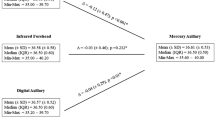Abstract
Abstract
Rectal and axillary temperatures were measured simultaneously in 83 children using three different thermometer devices providing 166 pairs of results. In the first series consisting of 22 febrile children (44 measurements) and 20 afebrile children (40 measurements), the rectal mercury measurement was compared to an axillary mercury and axillary Tempa-DOT thermometer. The axillary mercury had sensitivity of 14/22 (64%) and specificity of 20/20 (100%) while the Tempa-DOT had sensitivity of 15/22 (68%) and specificity of 19/20 (95%). In the second series comprising 21 febrile children (42 measurements) and 20 afebrile children (40 measurements) the axillary mercury had sensitivity of 11/21 (52%) and specificity of 20/20 (100%) while the electronic thermometer had sensitivity of 10/21 (48%) and specificity of 20/20 (100%). Regardless of the thermometer used, the axilla is a poor alternative to rectal measurements in the diagnosis of fever.
Conclusion
Mercury-free thermometers, when used in the axilla are as poor alternatives to reetal measurements as mercury-in-glass thermometers.
Similar content being viewed by others
References
Atkins E (1984) Fever: The old and the new. J Infect Dis 149:339–349
Blainey CG (1974) Site selection in taking body temperature. Am J Nurs 74:1859–1861
Blumethal I (1992) Should we ban the mercury thermometer? Discussion paper. J Royal Soc Med 85:553–555
Blumenthal I (1991) Which thermometer? The Lancet 337:1483
Chellapah G (1980) Aspects of thermoregulation in term and preterm newborn babies. University of Nottingham, Nottingham
Frank J D, Brown S (1978) Thermometers and rectal perforations in the neonate. Arch Dis Child 53:824–825
Karlberg P (1949) The significance of depth of insertion of the thermometer for recording the rectal temperature. Acta Paediatr Scand 38:359–366
Kresh MJ (1984) Axillary temperature as a screening test for fever in children. J. Pediatr 4:596–599
Morley CJ, Hewson PH, Thornton AJ, Cole TJ (1992) Axillary and rectal temperature measurements in infants. Arch Dis Child 67:122–125
Nichols G (1966) Oral, axillary and rectal temperature determinations and relationships. Narse Res 31:274–277
Ogren JM (1990) The inaccuracy of axillary temperatures measured with an electronic thermometer. Am J Dis Child 144:109–111
Payne D, Johnson A, McKenzie S, Rogers M (1994) Chemical and glass thermometers for axillary temperatures: how do they compare? Arch Dis Child 71:259–260
Smith L, Prince HN, Johnson E (1981) Bacteriologic studies on electronic hospital thermometers. Infect Contol 4:315–316
Author information
Authors and Affiliations
Rights and permissions
About this article
Cite this article
Zengeya, S.T., Blumenthal, I. Modern electronic and chemical thermometers used in the axilla are inaccurate. Eur J Pediatr 155, 1005–1008 (1996). https://doi.org/10.1007/BF02532519
Received:
Accepted:
Issue Date:
DOI: https://doi.org/10.1007/BF02532519




